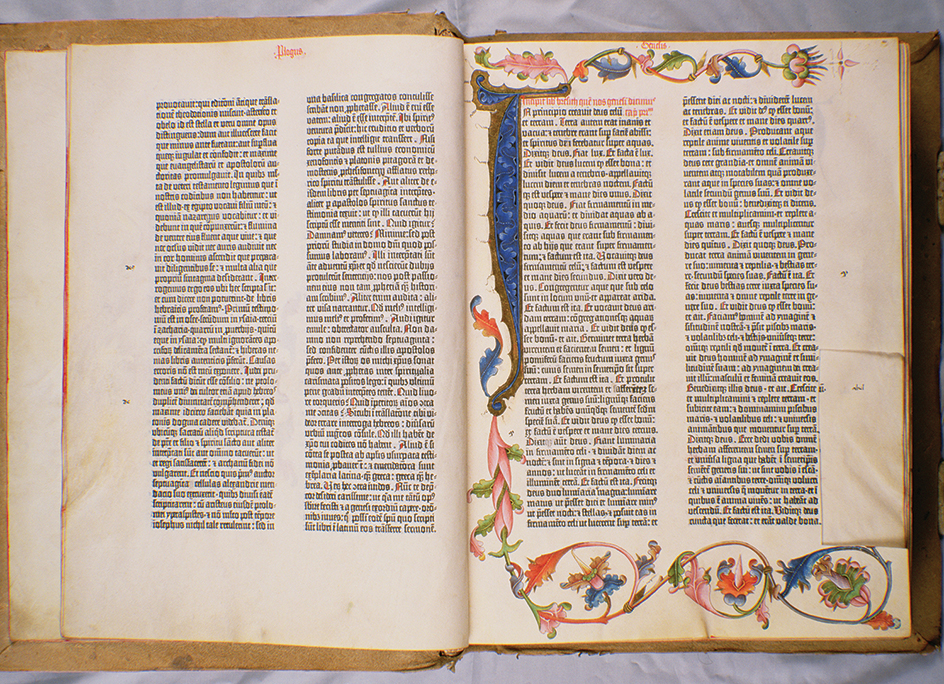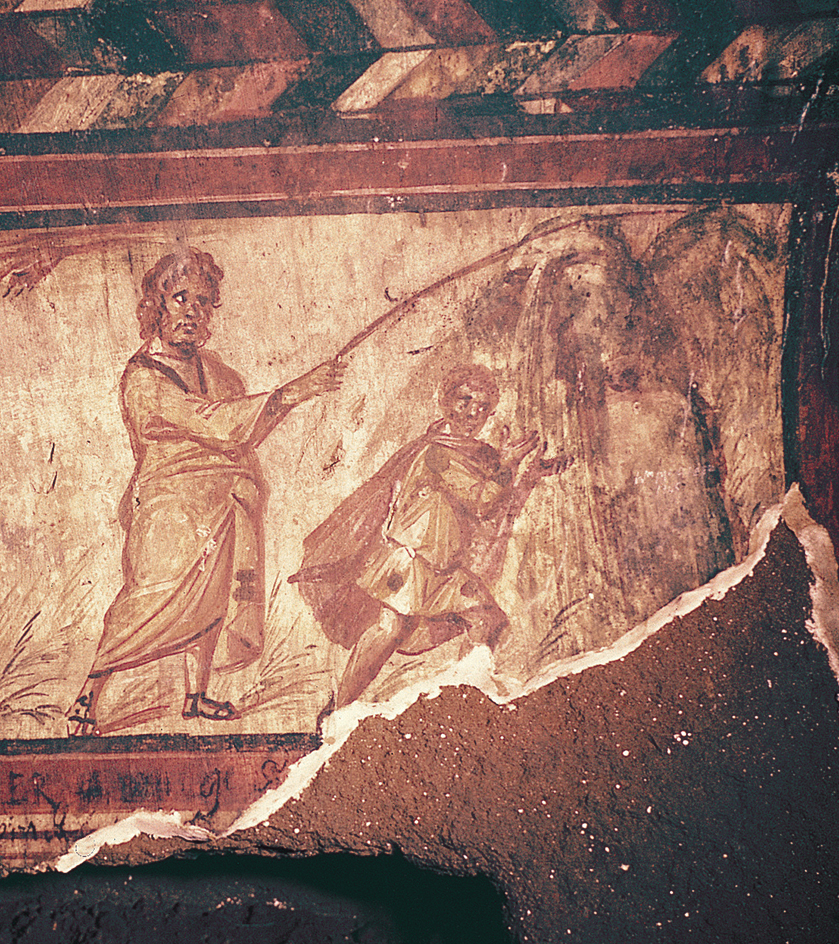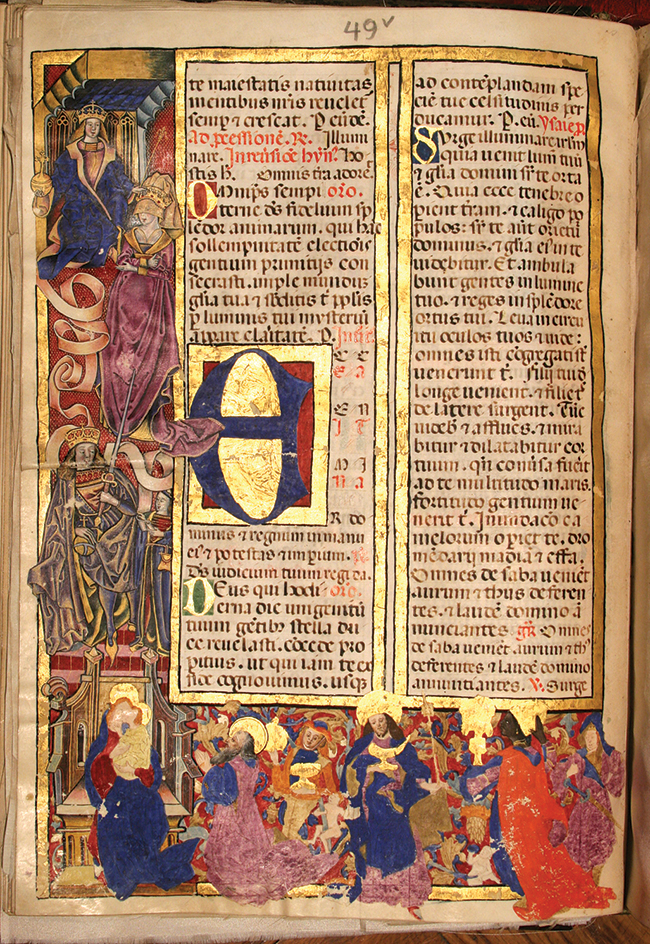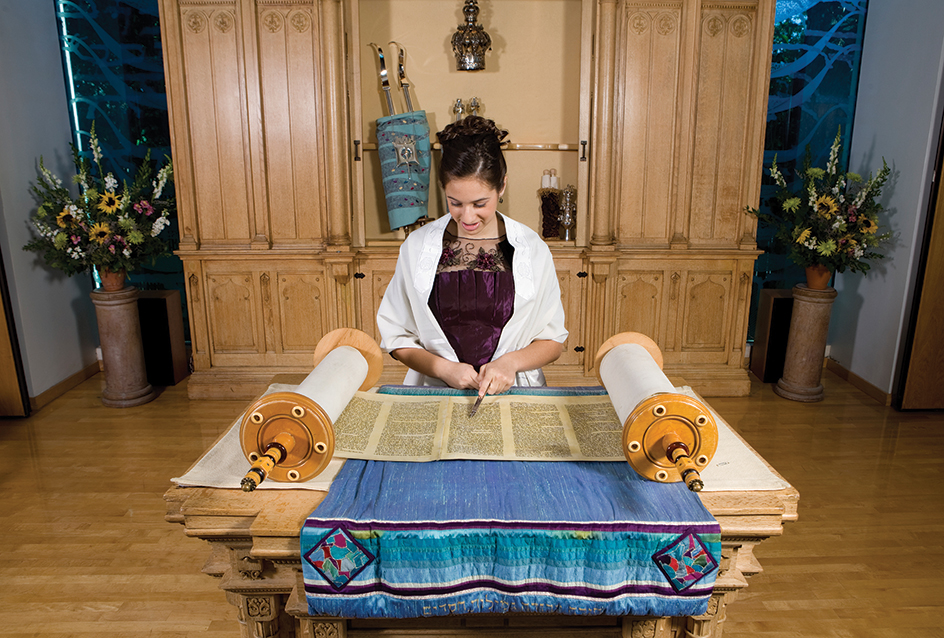Bible is the name given to several collections of writings considered sacred by Jews and Christians. The Bible is also known as the Holy Scriptures. Both Jews and Christians regard their Bible as inspired by God. But there are diverse opinions within each religious tradition about what divine inspiration means. The Bible contains important religious writings that also have great influence as literary works. The Bible is the most widely distributed book in history. It has been translated more times, and into more languages, than any other book.

The Bible is not a unified composition. It was not written by a single author at a specific time in history. The individual writings collected in the Bible are called books. The books accepted by any group as part of its Bible are called the canon.
The contents of the Bible and the order of the material have varied over time and from tradition to tradition. The Jewish Bible is commonly called the Hebrew Bible because most of it was written in Hebrew. The Hebrew Bible, which Christians call the Old Testament, forms the first part of the Christian Bible. The second part of the Christian Bible, called the New Testament, was written in Greek. Some Christian denominations include additional writings in the Old Testament that are not part of the Hebrew Bible.
The Hebrew Bible
The Hebrew Bible consists of 24 books. Most were written in Hebrew. A few parts, especially sections of the Books of Daniel and Ezra, were written in Aramaic. Aramaic is another ancient language in the same language group as Hebrew.
The books of the Hebrew Bible are organized into three sections—the Law, the Prophets, and the Writings. Jews call the Hebrew Bible the Tanak. The word Tanak is formed from the first letter of the Hebrew word for each section of the Bible—the Torah (Law), the Nebi’im (Prophets), and the Ketubim (Writings). No written sources tell how the Hebrew Bible developed. Scholars must look for clues almost entirely from the Bible itself.
The Law
consists of five books—Genesis, Exodus, Leviticus, Numbers, and Deuteronomy. It is also called the Torah, a Hebrew name meaning teaching, and the Pentateuch << PEHN tuh took >> , from two Greek words meaning five books. The Book of Genesis provides stories about God’s creation of the world and about early humans. According to Genesis, God made a covenant (agreement) with the ancestors of the Israelites. God promised that their descendants would become a nation and have a homeland. 
The other books of the Law tell the story of the Israelites, the ancestors of the Jews. The story begins with the tale of the Exodus. In the Exodus, the Israelites, led by Moses, escape from slavery in Egypt. The story continues with God giving Moses the Ten Commandments, a set of rules for living and worship, at Mount Sinai. Afterward, the Israelites wander in the wilderness for 40 years. The Law ends with the death of Moses at the entrance to the Promised Land of Canaan (later called Palestine). Canaan consisted of an area that extended roughly from east of the Jordan River to the Mediterranean Sea. It included what is now Israel. The Law also contains the Ten Commandments and many of the laws that form the basis of Judaism today. The Law was the first part of the Bible to be widely accepted as authoritative. A group of Jews called Samaritans still accept only this part of the Bible.
The Prophets
is divided into the Former Prophets and the Latter Prophets. The division is based on the order of the books in the Bible and not on the order in which they were composed.
The Former Prophets consists of four books—Joshua, Judges, Samuel, and Kings. These books form a continuous narrative that scholars call the Deuteronomistic History. Joshua begins where the Pentateuch ends and describes the conquest and settlement of Canaan. Judges describes the period after settlement when judicial and military rulers called judges governed the Israelites. The most famous judges included Deborah, Gideon, Samson, and Samuel. The Book of Samuel recounts the rise of the Israelite monarchy. The first king of Israel was Saul. David followed.
The Book of Kings begins with the end of David’s reign and the start of his son Solomon’s reign. Solomon was known for his wisdom. After Solomon, the land of the Israelites split into two kingdoms—Israel, in the north, and Judah (called Judea by the Romans), in the south. The Assyrian Empire conquered the northern kingdom in 722 or 721 B.C. The Book of Kings ends with the fall of Judah and the capture of its capital, Jerusalem, by the Babylonians in 587 or 586 B.C. The Babylonians sent the Israelite leaders into exile, beginning the Babylonian Exile, also called the Exilic Period.
The Latter Prophets also consists of four books. Three books relate teachings associated with prophets named Isaiah, Jeremiah, and Ezekiel. The fourth book, the Book of the Twelve, is made up of 12 smaller books that record the story of the prophet Jonah and the teachings of 11 other prophets. Rather than individuals who predicted the future, the prophets were social critics who confronted issues of their times.
Speeches in the Book of Isaiah deal with historical situations spanning more than 200 years. The early speeches come from the prophet Isaiah, who advised the kings of Judah in the 700’s B.C. Other sections of the book date to the time after the fall of Jerusalem, when the Israelites lived in exile. These later speeches are credited to an anonymous prophet whom scholars call Deutero-Isaiah (Second Isaiah). A third group of speeches dates to the period after 539 B.C., when the Israelites returned from exile. Scholars call these speeches from several anonymous prophets Trito-Isaiah (Third Isaiah).
Jeremiah and Ezekiel lived during the final days of the kingdom of Judah. Before the destruction of Jerusalem in 587 or 586 B.C., Jeremiah and Ezekiel proclaimed a message of doom against Jerusalem and Judah. During the exile, both prophets emphasized hope for the Israelites’ return to their home.
The Writings
consists of 11 books of various kinds. The Book of Psalms, which actually includes at least five ancient books, is a collection of religious songs and poems. Although traditionally credited to David, the individual psalms were written by many different people over several centuries. Another book, the Song of Songs, is a collection of love poems. It is also called the Song of Solomon, but Solomon probably did not write it. The Book of Lamentations consists of five poems that mourn the destruction of Jerusalem in the 580’s B.C. Loading the player...
Proverbs from the Bible
The Book of Ruth, set during the rule of the judges, tells the story of Ruth, a Moabite woman married to an Israelite. The Moabites and Israelites often clashed, but Ruth chose to remain with her mother-in-law after her husband and father-in-law died. The Book of Esther is set after the Israelites’ exile, when Persians ruled Judah. It tells the story of Esther, a young Jewish woman who saves her people from death.
The Book of Daniel claims to tell the story of a Jewish exile in Babylon in the 500’s B.C. But the imagery in the book refers to events in later centuries, up until about 167 B.C., when the book took its final form.
Chronicles (1 and 2 Chronicles in Christian Bibles) retells the history of the Israelites until 538 B.C., when the Persian king Cyrus the Great, after conquering the Babylonians, allowed the Israelites to return to Judah. Ezra-Nehemiah (two separate books in Christian Bibles) covers the period from 538 to about 430 B.C. Because the stories in Chronicles and Ezra-Nehemiah overlap, some scholars think these books are part of a larger history that they call the Chronicler’s Work. However, many experts dispute this idea.
Three books—Proverbs, Job, and Ecclesiastes—belong to a type of philosophical writings known as wisdom literature. Proverbs is a collection of wise sayings traditionally credited to Solomon. However, scholars believe the book did not take its final form until after the Babylonian Exile. Job concerns the unknowable nature of God in the face of human suffering. Ecclesiastes struggles with the brief, contradictory nature of human life.
The Christian Old Testament
When Christianity began to spread throughout the Greek-speaking world about the A.D. 50’s, Christians used a Greek translation of the Bible. This translation became the Christian Old Testament.
The Christian Old Testament is divided into four parts—the Pentateuch, the historical books, the wisdom books, and the Prophets. The Old Testament divides some of the books of the Hebrew Bible, increasing their number from 24 to 39. In addition, the Greek translation expanded the books of Esther and Daniel and added other books. Roman Catholic Bibles include the added material as part of the Old Testament. The canon of the Greek Orthodox Church is the same as that of the Catholic Church, with five additional books—1 and 2 Esdras, the Prayer of Manasseh, Psalm 151, and 3 Maccabees. The Ethiopian Orthodox Church has other books in its canon, including Jubilees and 1 Enoch.
In the A.D. 1500’s, some Protestant scholars became concerned that the Old Testament contained books not found in the Hebrew Bible. The scholars removed these books from their Old Testament and called them Apocrypha. For this reason, the Protestant Old Testament includes only those writings that form the Hebrew Bible.
Some Protestant editions of the Bible include the Apocrypha as a separate section. In the New Revised Standard Version of the Bible, for example, the Apocryphal books include Tobit; Judith; Additions to the Book of Esther; the Wisdom of Solomon; Ecclesiasticus, or the Wisdom of Jesus Son of Sirach; Baruch; the Letter of Jeremiah; Additions to the Book of Daniel; 1, 2, 3, and 4 Maccabees; 1 and 2 Esdras; the Prayer of Manasseh; and Psalm 151. The Roman Catholic, Greek, and Slavonic Bibles each include some of these writings in their respective canons.
The New Testament
In the A.D. 30’s, a Jew named Jesus began teaching in Galilee, the northernmost part of Palestine. He gathered a following of other Jewish men and women. His followers included a core group of 12 disciples later called the Apostles. Jesus’s followers called him Messiah, from a Hebrew word meaning anointed one, and Christ, from a Greek word with the same meaning. They soon spread his teachings throughout the Roman Empire, creating a movement that included both Jews and Gentiles (non-Jews). Eventually, this Christian movement became distinct from Judaism. The New Testament includes some of the earliest writings from this movement.
The New Testament includes 27 books organized into four sections—the Gospels, the Acts of the Apostles, the Letters, and Revelation. The New Testament books were composed in Greek, which was widely spoken during the time of Jesus. Jesus and his disciples spoke Aramaic.
The Gospels
consist of four books—Matthew, Mark, Luke, and John. Although they appear as the first books in the New Testament, they were not the earliest works to be written. The word gospel comes from the Old English word godspell, meaning good news.
The Gospels themselves do not mention their authors’ names. The early church credited them to the Apostles Matthew and John, and to Mark and Luke, both companions of Apostles. Today, most scholars doubt that these men actually wrote the Gospels.
All four Gospels describe the life of Jesus. Matthew, Mark, and Luke have similarities of wording, detail, and arrangement. They are called the Synoptic Gospels. Many scholars think that Mark is the earliest Gospel, and that the authors of Matthew and Luke used Mark as a source. This theory suggests a second source made up of the material common only to Matthew and Luke. This second source is called Q, from the German word Quelle, meaning source. Q is thought to consist mostly of sayings that do not fit together to form a narrative.
Most scholars think Mark was written just before or after the Romans captured Jerusalem in A.D. 70. Matthew and Luke were written between about A.D. 70 and 90. John took its final form later, perhaps in the A.D. 90’s.
Each of the four Gospels tells the story of Jesus differently. Mark’s story begins with Jesus’s baptism by John the Baptist. When Jesus is baptized, he hears a voice declaring him to be God’s son. In the ancient Mediterranean world, the term son of God often was a royal designation for the king. Jesus then begins proclaiming “the kingdom of God.” His teachings and miracles bring him into conflict with other Jewish leaders. Eventually, the Roman authorities crucify him.
The Gospel of Matthew begins with a genealogy, tracing Jesus’s ancestry back to King David. It also describes Jesus’s birth. Matthew portrays Jesus as the lawgiver who instructs his followers on how they should act. The Sermon on the Mount and the Lord’s Prayer appear in chapters 5-7. In Matthew, Jesus appears to his disciples after his death.
The Gospel of Luke is the first of a two-part composition that also includes the Acts of the Apostles. Luke begins with a birth narrative that differs from Matthew’s. Luke also provides a different genealogy, which traces Jesus’s ancestry back to “Adam, son of God.” It portrays Jesus as the savior of all people. Luke provides a shorter version of the Sermon on the Mount and a different version of the Lord’s Prayer than Matthew does.
The Gospel of John differs from the Synoptic Gospels of Matthew, Mark, and Luke in several ways. In the Synoptic Gospels, Jesus teaches chiefly with short sayings and brief stories called parables that explain the kingdom of God. In John, Jesus teaches using long statements that often focus on his identity. The Gospel of John describes Jesus as a divine being who existed before his human life, then “became flesh.”
The Acts of the Apostles
continues the story told in Luke. It was written by the same author. Acts describes the expansion of the early Christian Church. It gives numerous accounts of people joining the movement. The story ends in Rome, where the Christian missionary Paul is in prison.
The Letters
make up 21 books. They are also called the Epistles, from a Greek word meaning letter.
The first 13 letters are called the Pauline letters because Paul was believed to have written them. Galatians, 1 and 2 Corinthians, Philippians, and 1 Thessalonians are letters that address various situations in churches that Paul founded. Philemon is a letter to a Christian associate of Paul, urging him to free his slave Onesimus. Romans is a letter that deals with the relationship between Jews and Gentiles in the church. Scholars rarely question that Paul wrote these seven letters (Galatians, 1 and 2 Corinthians, Philippians, 1 Thessalonians, Philemon, and Romans). They are known as the “undisputed” or “authentic” Pauline letters. Composed in the A.D. 50’s and early 60’s, they are the earliest Christian writings.
Six other letters sometimes credited to Paul are Ephesians, Colossians, 2 Thessalonians, 1 and 2 Timothy, and Titus. Some scholars think Paul wrote all of these letters. Other thinkers doubt that he wrote any or all of them. These scholars see differences of style, vocabulary, and theology when they compare the six letters with the undisputed Pauline letters. These six letters are known as the “disputed” Pauline letters. Scholars who doubt their authenticity call them Deutero-Pauline letters, meaning that they were written by Paul’s followers.
The last eight books of the Letters are known as the General Letters. Most scholars dispute their authorship.
Hebrews is not an actual letter, but more likely a sermon. Scholars date this anonymous book between A.D. 60 and 90. Hebrews encourages people to maintain their commitment to Christ even when they experience persecution. It portrays certain elements of the Hebrew Bible as indications of the coming of Christ.
Scholars are not sure who wrote the Letter of James. Its author probably composed it in the last half of the first century A.D. The Letter of James offers teachings about what is right and wrong. The topics include humility and the dangers of speaking evil about others. The letter condemns favoring the wealthy over the poor. It also encourages its audience to combine faith with moral practices.
The two Letters of Peter claim to be written by Peter from Rome, but most scholars doubt that they were. The first letter urges its audience to respond to persecution by living a holy life, submitting to government authorities, and accepting suffering as Jesus did. The second letter has elements of a testament, the last message before someone’s death. It warns against false prophets whose teachings lead to lawless behavior and who deny that Christ will return to earth, an event known as the Second Coming.
The three Letters of John come from the same community that produced the Gospel of John. These books address a break within the community over whether Jesus came to earth as flesh and blood.
The authorship and date of the Letter of Jude are uncertain. Like 2 Peter, Jude warns against false teachers. It also predicts a final judgment of all people by God.
Revelation
is the final book of the New Testament. It is also called Apocalypse, from a Greek word meaning revelation. A man named John wrote the book, but he was probably not the same person who wrote the Gospel of John. Revelation gives a symbolic description of God’s final triumph over evil and death. It portrays the Roman Empire as Babylon, Israel’s historic oppressor, and the Roman emperor as the “beast.” The author claims to have received visions from an angel. The book concludes with a vision of a new heaven and a new earth, where God is present in “the new Jerusalem.”
Formation of the New Testament
The first generation of Christians preserved memories of Jesus Christ’s teachings, deeds, and Crucifixion largely by word of mouth. The story of Jesus was not written down in the Gospels until the A.D. 60’s.
The authors of the New Testament did not deliberately try to create a Christian Bible. The early church already had a Bible—the Hebrew Bible, which had been translated into Greek. But differing views of Christianity in the A.D. 100’s led the church to establish the New Testament canon as the authority against unacceptable religious views. The church also wanted to document Jesus’s story for future generations.
By about A.D. 200, the church canon included most of the present New Testament. In A.D. 367, Athanasius, the bishop of Alexandria, first defined the canon that today makes up the New Testament. All Christians gradually adopted this canon.
Translations of the Bible
The first translations
of the Bible were oral versions of the Hebrew Bible in Aramaic. An Aramaic translation is called a Targum, from a Hebrew word meaning translation. Translators made targums for Jewish communities that spoke Aramaic rather than Hebrew. Jews who spoke only Aramaic could not understand the Bible when it was read aloud in Hebrew. A translator would stand beside the reader in a synagogue and translate Hebrew passages into Aramaic. Rabbinic tradition suggests that the practice of translating the Torah into Aramaic originated with the prophet Ezra in the 400’s B.C.
Jews who lived in Greek-speaking parts of the world also needed a translation of the Bible. In the 200’s B.C., a group of scholars working in Alexandria, Egypt, translated the Pentateuch into Greek. According to tradition, King Ptolemy of Egypt called 70 or 72 Jewish scholars to Alexandria to translate the Pentateuch for his famous library. The story tells that the scholars, working separately, all arrived at the same translation. The translation is called the Septuagint << SEHP chu uh jihnt or SEHP tyu uh jihnt >> , from a Latin word meaning seventy. Later Greek translations of the rest of the Bible came to be considered part of the Septuagint.
Most of the first Christians spoke Greek, and so the early church used the Septuagint. But the need for more translations arose as Christianity spread to Syria and to Latin-speaking countries. Translations of Biblical books into the Syriac language of Syria and into Latin began to appear in the A.D. 100’s.
About A.D. 383, Saint Jerome began a revision of the Latin Bible at the request of Pope Saint Damasus I. As his sources for the Old Testament, Jerome used Hebrew and Greek texts and Latin translations. For the New Testament, he used Greek texts and Latin translations. He completed the project in A.D. 405. His version became known as the Vulgate, from the Latin word meaning popular. For centuries, it was the only version of the Bible authorized by the Roman Catholic Church. Church leaders discouraged translating the Bible into the languages of the people. If the Bible was in Latin, only learned people could read it and interpret its teachings.

Early English translations.
The first complete English translation of the Bible appeared in the 1380’s. The English priest John Wycliffe and his followers made it.
The German Protestant reformer Martin Luther translated the New Testament into German in 1522. He and his colleagues finished translating the rest of the Bible in 1534. About the same time, William Tyndale, an Englishman, translated the Bible into English while living in Germany. Tyndale based some of his translation on Luther’s German version. The vigorous language of Tyndale’s translation greatly influenced many later translations and revisions of the Bible in English.
Miles Coverdale, an English bishop, prepared the first complete English Bible to be printed. He used much of Tyndale’s translation, parts of Luther’s Bible, and the Vulgate. Coverdale’s Bible was printed in Germany in 1535.
English refugees living in France made the first Roman Catholic translation of the Bible from Latin into English. The New Testament was published in Reims (also spelled Rheims), France, in 1582. The Old Testament was published in Douay, France, in 1609 and 1610. The translation became known as the Douay-Rheims Bible or the Douay Bible.
The King James Version.
In 1604, King James I of England authorized a committee of about 50 scholars to prepare a revision of earlier English translations of the Bible. The new version appeared in 1611 and became known as the King James, or Authorized, Version. The beauty and grace of the translation established the King James Bible as one of the great treasures of the English language.
By the mid-1800’s, scholars and religious leaders were calling for fresh translations of the Bible. Scholars had more accurate knowledge of the original Hebrew and Greek texts and so uncovered many errors in the texts used by the King James revisers. Scholars also had gained more knowledge of ancient Middle Eastern languages, which added to their understanding of the languages used in the Bible. In addition, the English language itself had changed greatly over the years. Many words in the King James Version no longer had the same meaning or were even understood by readers of the Bible. For examples of how different translations treat a passage in the Bible, see the article Lord’s Prayer .
Modern English translations
of the Bible try to reproduce the flavor of everyday speech. The National Council of Churches, an organization that includes the major Protestant denominations in the United States, sponsored a translation called the Revised Standard Version. The New Testament was published in 1946, and the Old Testament in 1952. Several British Protestant churches sponsored a translation called the New English Bible, starting with the New Testament in 1961. American Protestant scholars prepared the New American Standard Bible, published in a complete version in 1971. The American Bible Society, a nonprofit organization that translates, publishes, and distributes Bibles, sponsored a version commonly known as the Good News Bible. It was finished in 1976. Kenneth N. Taylor, an American author, created The Living Bible in 1971. Taylor paraphrased existing translations to make them easier to read. The New York Bible Society, a nonprofit organization now known as Biblica, sponsored the New International Version. It was completed in 1978, with an updated version in 2010. Tyndale House Publishers, founded by Taylor, published the New Living Translation in 1996. It was based on Taylor’s principles.
Before the mid-1800’s, English-speaking Jews used either the original Hebrew text or the King James Version of the Old Testament. In 1917, two organizations published a new English translation of the Hebrew Bible. They were the Jewish Publication Society of America, a nonprofit publisher of Jewish books, and the Central Conference of American Rabbis, a group of rabbis in the Reform branch of Judaism. The Jewish Publication Society also sponsored a new translation, completed in 1982.
In 1973, a new edition of the Revised Standard Version appeared as the Common Bible. This edition was the first English translation of the Bible to be approved by Greek Orthodox, Protestant, and Roman Catholic religious leaders. In 1990, leaders of the major Christian faiths endorsed another new edition called the New Revised Standard Version. This edition, sponsored by the National Council of Churches, replaced many masculine words with words applying to both sexes.
The Bible in worship
Jews and Christians use the Bible in private and public worship. In public worship, Jews and many Christian denominations read parts of the Bible according to an official schedule called a lectionary. 

There once were two systems of Torah reading in synagogues on the Sabbath. In Babylonia, Jews read the entire Torah every year. In Palestine, the reading took from 3 to 3 1/2 years to complete. Eventually, the Babylonian system became the accepted one. The holiday of Simhat Torah was established between the A.D. 800’s and the 1400’s, during the Middle Ages, to celebrate the end of each annual reading cycle.
In some Protestant churches, the minister selects the Bible readings, which may be related to the topic of the sermon. Bible readings also are included in morning and evening prayer services of the Church of England and other Anglican churches.
In the Roman Catholic Church, the clergy and, in some cases, ministerial assistants read Bible passages during Mass. A series of daily prayers called the divine office consists almost entirely of Bible passages. In addition, parts of the Bible are read during such ceremonies as baptisms, funerals, and weddings.
The Book of Psalms has an important role in Jewish and Christian worship. Many psalms have been set to music and are sung as hymns during religious services.
Methods of interpreting the Bible
Readers have long disagreed about the meaning of the Bible. Their differences of opinion result from the various convictions and assumptions that they bring to the text. Some people believe that every event mentioned in the Bible happened exactly as the Bible says it did. Others think many events must be read as symbols.
Scholars have developed several ways of interpreting the Bible. These interpretations set a particular Bible passage in different historical or literary contexts (backgrounds).
Historical contexts.
Historians of the Bible traditionally have focused on two distinct historical contexts. The first is the context of the events portrayed in the Bible. Some historians try to reconstruct what actually happened during Biblical times. Scholars have confirmed some events described in the Bible through archaeology and the study of documents written by other ancient peoples. For example, they have discovered Cyrus’s decree ending the Babylonian Exile. Other Bible stories, such as the Israelites’ conquest of Jericho (Joshua 6), do not match the archaeological evidence.
The second context that historians of the Bible examine is the situation in which a text was composed. This context includes such information as who the author was, when a text was written, and what were the conditions in the community that the author was addressing.
Often, historians aim to discover the different sources used to create a Biblical book or collection of books. For example, scholars have identified several different sources that were combined to form the Pentateuch.
Other historians examine how sources were brought together to form books of the Bible. For example, in the case of the Synoptic Gospels, scholars theorize that the authors of Matthew and Luke used the Gospel of Mark and Q as their sources. These historians, called redaction critics, focus on how the authors of Matthew and Luke redacted (edited) Mark and Q to meet the needs of their own communities.
Literary contexts.
Some Biblical scholars compare the different manuscripts of books of the Bible and try to determine the original text of the books. There are many ancient and medieval copies of books of the Bible. Until the mid-1900’s, most English translations of the Hebrew Bible were based on manuscripts of the Masoretic Text from about A.D. 1000. In the ancient world, numerous versions of the books of the Bible circulated. Modern scholars refer to different versions of books of the Bible as text types. The Masoretic Text is one of these text types.
Beginning in 1947, more than 200 ancient manuscripts of books of the Hebrew Bible were found along the western shore of the Dead Sea. These Dead Sea Scrolls date from the late 200’s B.C. to A.D. 68. Some of them resemble the Masoretic Text. Others are similar to ancient translations of the Bible into Greek and other languages. Still others preserve different text types.
There are more than 3,000 manuscripts of the books of the New Testament. Early translations of Bible passages and quotations from the Bible also appear in ancient non-Biblical writings. These manuscripts preserve different text types.
Another scholarly approach compares Bible passages with other writings that have the same form. The Bible includes many forms of writing, such as history, laws, letters, poems, prayers, prophecies, songs, and stories. Scholars have found many similarities between the legal and literary traditions of the ancient Hebrews and the writings of other Middle Eastern cultures. Such writings include Mesopotamian law codes, Egyptian wisdom literature, and Canaanite poetry. Likewise, scholars compare passages in the New Testament with Greek and Roman written history, letters, and literature.
Narrative interpretation approaches the Bible as literature. Narrative interpreters focus on such things as how the plot develops in a Biblical story and how the characters are portrayed.
Contexts of other readers.
Other interpretations consider how the Bible has been read and understood over time and by different groups of people. For example, one scholar might examine how early European settlers in the New World viewed the story of Moses leading the Israelites to the Promised Land. Another might investigate how black slaves in the United States used the Biblical story of the Exodus in their own stories and songs, or how the African American civil rights leader Martin Luther King, Jr., used it in his sermons. 
All of the different contexts used by scholars to study the Bible produce different interpretations of it. It is the richness and depth of the Biblical books that enable people in various situations and of different religious traditions to find meaning and inspiration in them.
